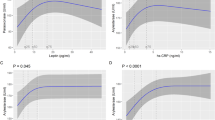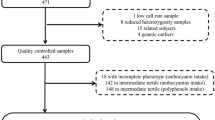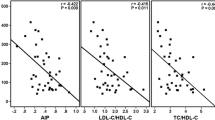Summary
Background
Greek migrants to Australia have low allcause and cardiovascular disease (CVD) mortality. This may be partly due to maintenance of a traditional Mediterranean diet and its interaction with CVD risk factors. The enzyme paraoxonase–1 (PON1) is thought to contribute to the anti–atherogenic properties of high density lipoproteins (HDL) by metabolizing lipid peroxides. PON1 activity is subject to modulation by dietary and genetic factors.
Aims
To determine PON1 activity in Greek migrants and Anglo–Celtic subjects recruited from the Melbourne Collaborative Cohort Study, and its relationship to coronary risk factors and dietary markers.
Methods
Greek (n = 127) and Anglo–Celtic (n = 128) participants in the MCCS were recruited. By design, there were approximately equal numbers of men and women and of diabetic and non–diabetic subjects. Subjects were screened for glucose tolerance, dyslipidaemia, hypertension and coronary heart disease. Plasma markers of diet (carotenoids, retinol, tocopherol, homocysteine) and inflammation (C–reactive protein) were assessed. Serum PON1 activity was determined spectrophotometrically using two substrates: paraoxon (paraoxonase) and phenylacetate (arylesterase).
Results
PON1 activity was significantly higher in the presence of hyperlipidaemia but otherwise did not vary by ethnicity, presence of coronary heart disease, diabetes, hypertension or smoking. Among subjects with the high activity phenotype (defined by the ratio of paraoxonase:arylesterase activity), paraoxonase activity correlated directly with circulating diet–derived carotenoid concentrations for Greeks, and inversely with homocysteine and C–reactive protein for Anglo–Celtics. No such associations were seen among subjects with the low activity phenotype.
Conclusions
The data suggest that dietary modulation of atherosclerotic risk may vary according to PON1 phenotype.
Similar content being viewed by others
Author information
Authors and Affiliations
Corresponding author
Rights and permissions
About this article
Cite this article
Lee, C.T., Rowley, K., Jenkins, A.J. et al. Paraoxonase activity in Greek migrants and Anglo–Celtic persons in the Melbourne Collaborative Cohort Study: relationship to dietary markers. Eur J Nutr 44, 223–230 (2005). https://doi.org/10.1007/s00394-004-0514-y
Received:
Accepted:
Published:
Issue Date:
DOI: https://doi.org/10.1007/s00394-004-0514-y




